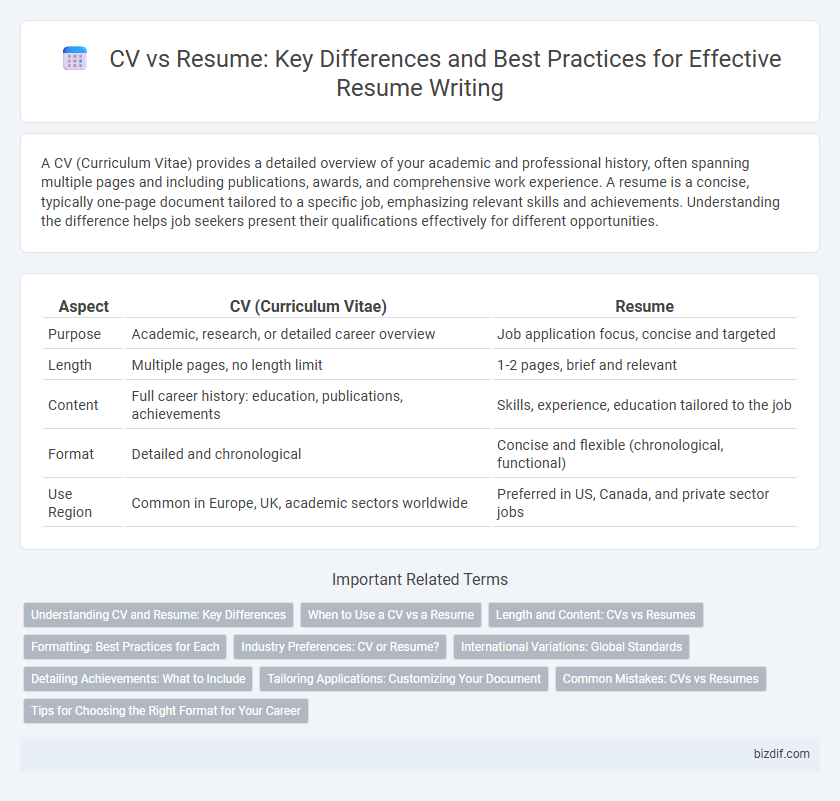A CV (Curriculum Vitae) provides a detailed overview of your academic and professional history, often spanning multiple pages and including publications, awards, and comprehensive work experience. A resume is a concise, typically one-page document tailored to a specific job, emphasizing relevant skills and achievements. Understanding the difference helps job seekers present their qualifications effectively for different opportunities.
Table of Comparison
| Aspect | CV (Curriculum Vitae) | Resume |
|---|---|---|
| Purpose | Academic, research, or detailed career overview | Job application focus, concise and targeted |
| Length | Multiple pages, no length limit | 1-2 pages, brief and relevant |
| Content | Full career history: education, publications, achievements | Skills, experience, education tailored to the job |
| Format | Detailed and chronological | Concise and flexible (chronological, functional) |
| Use Region | Common in Europe, UK, academic sectors worldwide | Preferred in US, Canada, and private sector jobs |
Understanding CV and Resume: Key Differences
A CV (Curriculum Vitae) is a detailed document outlining a candidate's academic background, work experience, publications, and professional achievements, often used in academic, research, and international job applications. A resume is a concise summary of relevant skills, work experience, and education tailored to a specific job, typically limited to one or two pages. Understanding these key differences helps job seekers select the appropriate format to effectively showcase qualifications to employers or academic institutions.
When to Use a CV vs a Resume
A CV is typically used for academic, research, or international job applications where detailed work history, publications, and credentials are required, while a resume is preferred for most corporate and non-academic positions due to its concise, tailored format. Understanding the industry and geographic location is essential, as CVs are standard in Europe and the Middle East, whereas resumes dominate in the United States and Canada. Choosing between a CV or resume depends on the job description's requirements and the depth of professional experience needed to showcase.
Length and Content: CVs vs Resumes
CVs typically span multiple pages and provide a comprehensive overview of one's academic achievements, research, publications, and professional experience. Resumes are concise, usually limited to one or two pages, and tailored to highlight relevant skills and accomplishments for specific job applications. The content of a CV is detailed and chronological, while resumes prioritize brevity and relevance to the position.
Formatting: Best Practices for Each
CVs typically follow a detailed chronological format with clear headings for education, research, and publications, emphasizing a comprehensive record suitable for academic or research positions. Resumes prioritize concise, tailored formats highlighting relevant skills and achievements, often using bullet points and sections like summary, experience, and skills to quickly capture employer attention. Best practices for formatting each include maintaining consistent fonts, appropriate margins, and clear section separation, ensuring readability and professionalism aligned with industry standards.
Industry Preferences: CV or Resume?
In the United States and Canada, resumes are preferred for most industries due to their concise format highlighting key skills and experience. In contrast, academic, scientific, and research sectors favor CVs because they provide detailed accounts of education, publications, and professional accomplishments. Understanding these industry preferences helps tailor application documents to meet employer expectations effectively.
International Variations: Global Standards
CVs in Europe and academic fields typically span multiple pages and detail comprehensive career histories, while resumes in the United States and Canada are concise, usually limited to one or two pages focusing on relevant skills and experience. International variations include the inclusion of personal information and photographs in CVs common in countries like Germany and France, which are generally avoided in U.S. resumes to prevent bias. Global standards emphasize tailoring documents to regional expectations, where understanding local norms enhances the effectiveness of job applications across different countries.
Detailing Achievements: What to Include
When detailing achievements in a CV, emphasize comprehensive and quantifiable accomplishments, including awards, research, publications, and professional affiliations to showcase depth and expertise. A resume highlights specific, targeted achievements relevant to the job, such as successful projects, measurable results, and key skills demonstrated in previous roles. Tailoring the level of detail and type of achievements to the document's purpose enhances relevance and impact for hiring managers.
Tailoring Applications: Customizing Your Document
Tailoring applications by customizing your CV or resume enhances relevance for specific job opportunities, increasing the chances of passing applicant tracking systems (ATS). A resume is typically concise, around one to two pages, highlighting skills and experience directly related to the job, while a CV provides a comprehensive overview of your entire career, including academic achievements and publications, mainly for academic or research positions. Customizing each document with targeted keywords and accomplishments aligned with the job description ensures better visibility and impact during the hiring process.
Common Mistakes: CVs vs Resumes
Confusing a CV with a resume often leads to length and content errors, as CVs are comprehensive and detailed, while resumes are concise and tailored. Common mistakes include using a CV's exhaustive format when a brief resume is needed, and omitting crucial academic and research details that belong in a CV but not a resume. Understanding the distinct purposes and formats prevents miscommunication with recruiters and increases job application effectiveness.
Tips for Choosing the Right Format for Your Career
Choosing the right format for your career depends on highlighting your strengths effectively: use a chronological resume to emphasize steady work history, a functional resume to showcase skills for career changers or gaps, and a combination resume to balance both. Tailor the format to the job description and industry standards, ensuring key achievements and relevant keywords are prominently featured for applicant tracking systems (ATS). Prioritize clarity, relevance, and consistency to create a professional impression that aligns with your career goals and employer expectations.
CV vs Resume Infographic

 bizdif.com
bizdif.com